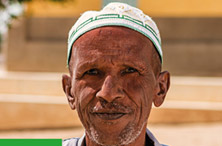Hepatitis A and E
 Hepatitis can cause jaundice, or a yellowing of the skin and eyes, due to bile duct obstruction (Photo: Dr. Thomas F. Sellers, Emory University/CDC)
Hepatitis can cause jaundice, or a yellowing of the skin and eyes, due to bile duct obstruction (Photo: Dr. Thomas F. Sellers, Emory University/CDC)
Hepatitis A and E
Viral hepatitis is a group of viruses (hepatitis A, B, C, the rarer type D, and E) that can cause both acute and chronic infection and inflammation of the liver. The viruses are commonly transmitted via contaminated blood or blood products, or invasive medical procedures using contaminated equipment. Hepatitis A and E are typically caused by ingestion of contaminated food or water.
Hepatitis A
Hepatitis A causes mild to severe illness in an estimated 1.4 million people per year, with a further 113 million people being infected but not developing symptoms. Although the disease is rarely fatal and patients that recover have a lifelong immunity, it can cause debilitating symptoms and in rarer cases deadly acute liver failure (fulminant hepatitis). Hepatitis A occurs sporadically and in epidemics worldwide, with a tendency for cyclic recurrence. The virus is one of the most frequent causes of foodborne infection. Although the actual burden of hepatitis A in the Eastern Mediterranean Region remains unknown but outbreaks have repeatedly occurred in displaced population and refugee settings of countries affected by crisis or humanitarian emergencies. Recently hepatitis A genotype 1B has been detected in Syria. Circulation of other genotypes of hepatitis A virus in the Eastern Mediterranean Region presently remain unknown.
A safe and effective vaccine is available to prevent hepatitis A, which is a part of routine national children immunization programs in Saudi Arabia, Bahrain, and Iraq. In addition to vaccination efforts, a safe water supply, food safety, improved sanitation, and hand washing are the most effective ways to prevent the disease. Treatment focuses on rest and ensuring adequate nutrition and hydration.
Hepatitis E
An estimated 20 million people are infected with hepatitis E every year, leading to 3.3 million symptomatic cases. In 2015, hepatitis E caused approximately 44,000 deaths globally.
Although the actual burden of hepatitis A in the Eastern Mediterranean Region remains unknown but outbreaks have repeatedly occurred in displaced population and refugee settings of countries affected by crisis or humanitarian emergencies.
The Hepatitis E virus has at least four different genotypes, of which two have been found only in humans. While hepatitis E genotype 1 has been detected in Afghanistan, Iran (Islamic Republic of), Iraq, Libya, Morocco and Sudan, both the hepatitis E genotype 1 and 2 were detected in Egypt amongst the Eastern Mediterranean Region countries. Infection happens mainly through contaminated drinking water, and is usually self-limiting, which means it resolves within 2–6 weeks.
In rare cases, acute hepatitis E can lead to acute liver failure (fulminant hepatitis) and death. Pregnant women with hepatitis E are at increased risk, particularly during the second and third trimester, with third trimester case fatality rates reaching 20–25%.
A vaccine to prevent hepatitis E virus infection has been developed and is licensed in China, but is not yet available elsewhere. As with Hepatitis A, prevention efforts focus on raising awareness and maintaining safe water, proper sanitation, and proper hygiene. No specific treatment exists, although people who develop chronic hepatitis E benefit from antiviral treatment.











